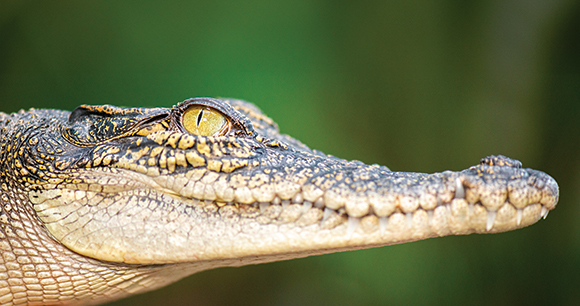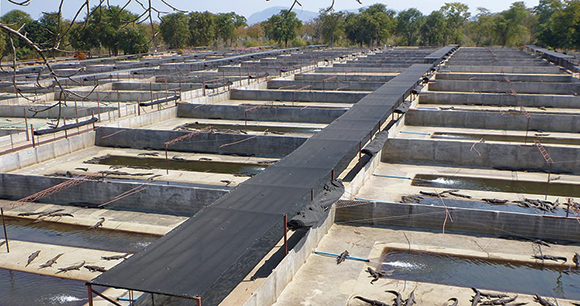It’s no skin off their backs. That’s why the multibillion-dollar, luxury fashion accessories market continues to peddle shoes, wallets, gloves, purses, and belts made from exotic animal skins to those consumers who still desire such goods and can afford the hefty price tag. Every year, millions of crocodiles, alligators, lizards, snakes, and other wild animals are brutally killed to manufacture high-end products intended to serve as conspicuous indicators of exalted style and status.

Across three continents, animals slaughtered for their skins routinely endure horrific abuse at production facilities linked to major fashion houses, including some that tout their animal welfare records. Although nearly every major designer and retailer has stopped using skins from foxes, minks, seals, and other furbearers—and far fewer people are willing to wear such products due to highly publicized cruelty investigations and the massive carbon footprint of fur farms—major fashion brands still routinely use exotic skins from other animals. LVMH Moët Hennessy Louis Vuitton (the world’s largest luxury goods conglomerate) and fellow holdouts Hermès, Prada, and Kering (which produces the Balenciaga, Gucci, and Yves Saint Laurent brands) continue to profit from profoundly cruel products that threaten the very existence of an increasing number of species.
AWI recently joined a coalition of animal welfare and conservation organizations determined to topple the cruel and unnecessary exotic-skins industry. The coalition is urging compassionate consumers to never buy or wear exotic skins, to educate others about the culture of lawlessness and immense suffering inherent to the exotic-skins trade, and to pressure companies through petitions and other methods to sever ties with the industry.
Miserable Life, Miserable Death
Investigative footage obtained by People for the Ethical Treatment of Animals (PETA) has repeatedly revealed that alligators raised for their skins are often packed together in pools of fetid water, which is not only inhumane but also a breeding ground for disease. Similarly, crocodiles by the thousands are confined to concrete pits from birth until slaughter, and are denied even the most basic comforts, including clean drinking water and veterinary care.
Both alligators and crocodiles held in facilities that supply the fashion industry are typically electroshocked, are stabbed in the back of the neck, or have a metal rod jammed into and down their spinal canal. They are then skinned—sometimes while still alive.

Most snakes in the exotic-skins trade are captured from their natural habitat. Others raised in captivity are forced to spend their lives in small, barren boxes or cages. To make them easier to skin, workers often inflate live and unstunned snakes with air or water using a compressor. They are also commonly nailed to trees and slit open from end to end while alive. Due to their slow metabolisms, it can take them anywhere from hours to weeks to die.
Industry workers have been documented bludgeoning struggling lizards before hacking their heads off with machetes. Since decapitation does not cause instantaneous death in lizards, their brains are able to register physical pain and psychological stress after decapitation.
More recently, workers at two Thai facilities were observed pinning struggling pythons down by the neck, bashing them on the head with a hammer, and ramming metal hooks through their heads. One of the facilities claimed to hold 15,000 snakes, including 2,000 females used for breeding.
Regulatory Limits
Although the Convention on International Trade in Endangered Species of Wild Fauna and Flora (CITES) requires certain aspects of international trade to be carried out in a humane manner, the global agreement is limited in scope and only applies to listed species. Additionally, the wildlife trade’s complexity and lack of transparency often make it exceedingly difficult to discern whether the animals were captive-bred or wild-caught, and how they were handled and killed.
Illegal trade in exotic skins is rampant, with poor policing, weak penalties, and a lack of accountability throughout the supply chain. For example, while trade in anacondas and crocodiles is covered by CITES, it is estimated that for every animal legally bred in captivity for the exotic-skins trade, another will be illegally taken from the wild. Of the top six countries exporting reptile skins (Colombia, Indonesia, the United States, Malaysia, Vietnam, and Argentina), five are also the top sources of illegal skins.
Moreover, the international wildlife trade can lead to outbreaks of zoonotic (animal-borne) diseases. “Wet” markets, where live animals—including wild species—are sold for human consumption, are breeding grounds for zoonotic pathogens like SARS-CoV-2, which caused the COVID-19 pandemic. The farms that supply exotic skins can pose similar risks due to cramped quarters, stressed animals, and extensive human contact with the animals.
Day of Reckoning?
Removing wildlife from landscapes can plunge ecosystems into disarray. Reptiles play a critical ecological role. They consume rodents and insects that can harm agricultural production and transmit disease to humans, and in turn are consumed by birds of prey and other predators. They also reduce carrion, control insect populations, and help maintain plant diversity by spreading seeds and cycling nutrients through ecosystems.
Trapping devices used to catch reptiles, including snares and nets, often capture nontarget species as well, which can further erode ecosystem health. Considering the myriad other threats to reptiles, including habitat loss and fragmentation, pollution, climate change, disease, capture for the pet or venom trade, and killing for food or out of fear, the extirpation (local extinction) of many species is all but assured without dramatic, immediate action.
Fortunately, a day of reckoning could be coming for exotic-skins fashions, similar to what precipitated the downfall of the fur industry. Many fashion brands—including Chanel, Tommy Hilfiger, Calvin Klein, Diane von Furstenberg, Victoria Beckham, Jil Sander, Vivienne Westwood, Tory Burch, Marc Jacobs, and Brooks Brothers—have refused to use exotic skins. Likewise, Helsinki Fashion Week, Melbourne Fashion Week, and Stockholm Fashion Week have banned exotic skins from runways.
Caring consumers can help keep this momentum going by choosing durable, sustainable alternatives such as vegan leather made from eco-friendly plants, refusing to purchase items from companies involved in the cruel exotic-skins trade (while encouraging friends and family to do the same), and visiting AWI’s Action Center to send a clear message to industry holdouts that wild animal parts have no place in fashion.